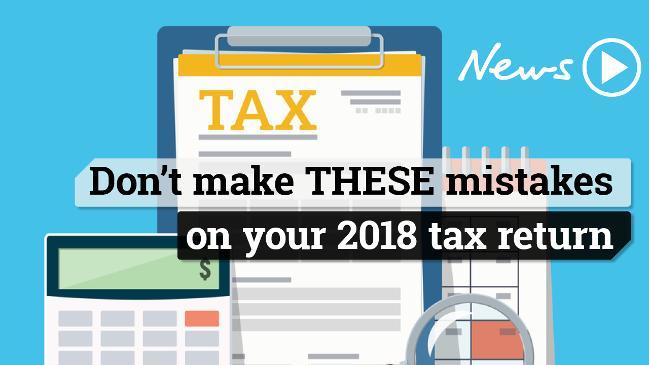ATO cracks down on home office claims
IT’S one of the most common claims people make on their tax return and you will face a big penalty if you don’t follow this rule.

PHONE and internet are among the most commonly claimed work-related expenses at tax time.
But unless you have documentation to justify claiming a particular percentage of your total bill, the Australian Taxation Office could knock your deduction down from hundreds of dollars to just $50 — the maximum that can be claimed without supporting evidence.
With technology enabling more Australians to work from home than ever, the ATO says a high number of mistakes, errors and questionable claims has forced it to increase scrutiny on home office expenses this year.
“Claims for the work-related portion of expenses like phone, internet, depreciation of your computer, printing and stationery are all allowed,” ATO assistant commissioner Kath Anderson said in a statement.
“But one of the biggest issues we are seeing is people claiming the entire amount of expenses like their internet or mobile phone, not just the extra bit related to work. In reality, the rest of us are subsidising their private phone calls and internet usage, which is not OK.”
Ms Anderson said the while extra costs related to working from home were usually deductible, taxpayers were either over-claiming or claiming private costs.
“There is mounting evidence that many taxpayers don’t know what they can and cannot claim,” she said.
“In particular, we are seeing some taxpayers claiming expenses they never paid for, expenses their employer reimbursed, private expenses and expenses with no supporting records.”
Electricity for heating, cooling and lighting may be deductible, but you must be able to demonstrate they were additional costs.
“If working from home means sitting in front of the TV or at the kitchen bench doing some emails, it’s unlikely that you are incurring any additional expenses,” Ms Anderson said. “However, if you have a separate work area, then you can claim the work-related portion of running expenses for that space.”
On the other hand, employees “cannot generally claim occupancy-related expenses like rent, mortgage repayments, property insurance, land taxes and rates,” she said. She warned employers were sometimes contacted to verify expenses.
“Sometimes we discover that the employer paid the costs, either upfront or through reimbursement, while other times we discover there was no need for the employee to work from home at all,” she said.
Ms Anderson said record keeping was a key focus this year.
“This tax time we expect to disallow a lot of claims where the taxpayer hasn’t kept records to prove that they legitimately incurred the expense and that the expense was related to their work,” she said.
“To claim working from home expenses, taxpayers must keep supporting records such as receipts, diary entries and itemised phone bills or other records. Even though detailed receipts are not required for phone and internet claims up to $50 per year, it’s not an automatic entitlement — you still need to be able to show how you calculated your claim.”
In one case study outlined by the ATO, an architect claimed 80 per cent of his private mobile phone and home internet as a work-related expense, but when asked to provide evidence, he only supplied his non-itemised bills.
He had not maintained a diary or other record demonstrating how he arrived at 80 per cent, and his employer was unable to verify the extent to which he was required to use his private phone and internet for work — the ATO knocked his claim down to $50.
In another case, a school principal claimed home office expenses for electricity and phone of $2400. While the school confirmed they were required to work from home, neither could demonstrate how the claim was calculated.
The principal admitted they had made an incorrect claim and should have instead used the fixed rate of 45 cents per hour. As a result, the claim was reduced by 70 per cent, and a penalty was applied for not taking reasonable care when preparing the return.
In a third case, an advertising manager claimed a home office deduction for her rent and electricity costs. She said she was required to work at home outside regular hours because a lot of business was generated from overseas clients.
Even though she provided the calculations for her claims, the ATO found the area did not have the character of a “place of business”, such as a hairdresser’s home salon, caterer’s home kitchen or a photographer’s home studio.
This meant that her claim for electricity costs — running expense — was allowed, her claim for rent — occupancy expense — was disallowed, and a penalty was applied for failing to take reasonable care.
With two months left to go in tax time, a record 5,775,000 taxpayers have already lodged returns, with 5,155,000 refunds issued totalling more than $11.9 billion — an increase of $270 million on this time last year.
The ATO has so far adjusted 112,000 returns, correcting $53 million worth of errors. The average tax refund is approximately $2300, while the median is about $1400. According to Etax.com.au, surgeons had the highest work-related claims by occupation with an average deduction of $21,184.
Real estate agents claim an average of $8616, lawyers claim an average of $6861, truck drivers claim an average of $5058 and tradies claim an average of $4998. Rounding out the top ten were farmers on $4450, engineers on $4177, vets on $3468, accountants on $3169 and teachers on $3172.
“One reason for this is that surgeons generally aren’t reimbursed for any of their many, many expenses by their employer,” Etax.com.au senior tax agent Liz Russell said.
“This means all those expenses can generally be claimed on their return instead. Unlike many other professionals, surgeons are generally required to take a certain number of special training courses to keep up with the latest medical practices.
“Additionally, surgeons can claim costs for textbooks, other learning materials, home office computers, furniture for study and travel costs associated with attending courses. Plus they often need their own insurance which can run into the thousands, or in some cases, tens of thousands of dollars per year.”




